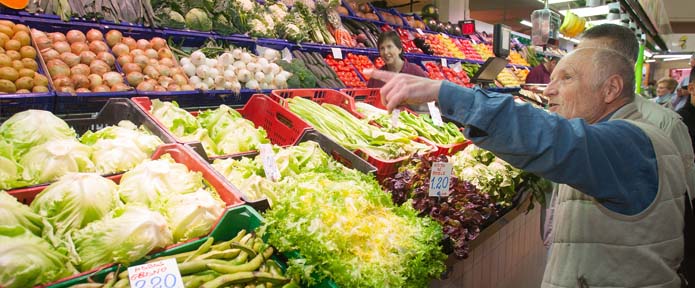Antonio López: "The meeting with people with a natural ability for painting is wonderful".
The artist visited this Monday the Ensanche Market in Pamplona to acquire the necessary products for the still lifes of the painting workshop he is teaching at the Museum this week.

The daily movement of the Ensanche Market in Pamplona has changed this Monday with the visit of Antonio López who, as is tradition, has come to buy the products that he will use in the XI Painting Workshop Masters of Figuration that he teaches at the Museum until Friday.
Accompanied by fellow painter Juan José Aquerreta, the artist toured different stalls to acquire seasonal fruits and vegetables, canning jars, eggs, flowers and even ham bones that will be used for the still lifes that the students will paint in the workshop. "We look for colors, shapes and combinations, elements that contrast and complement each other. You can't just place anything," explained López next to one of the stalls.
He also noted that he feels "a great joy to return to the workshop, in which there are some repeaters". This eleventh edition involves 25 students who, early in the morning, have been able to meet the artist and begin to paint a model that has posed for them. "They are people advanced in painting, from different backgrounds and ages. There are people who are studying Fine Arts and also people who want to take it up again over the years, in the company of other painters. Every year they are different people and so am I."
In this sense, he emphasizes that many are an example of "generosity and imagination" and that he finds "extraordinary surprises": "The meeting with people with a natural ability for painting is a marvel".
In the workshop they explore the figurative tradition through the genres of still life, the human figure with natural models and landscape. López and Aquerreta accompany the participants in the creative process, sharing their experience and committee.
About the world of Fine Arts, Lopez, considered one of the main exponents of Spanish realism, stresses that "it is very difficult and exciting, above all, because of the possible ways of making art, knowing what is yours, the search for that identity".
Thus, the workshop is "an opportunity to see which path you have to follow. We all have a lot of doubts and it is a relief". Until Friday they will work in the Museum's workshops and, at the end of the workshop, the artist will choose a maximum of two of the students' works, which will be incorporated into the Collection.
